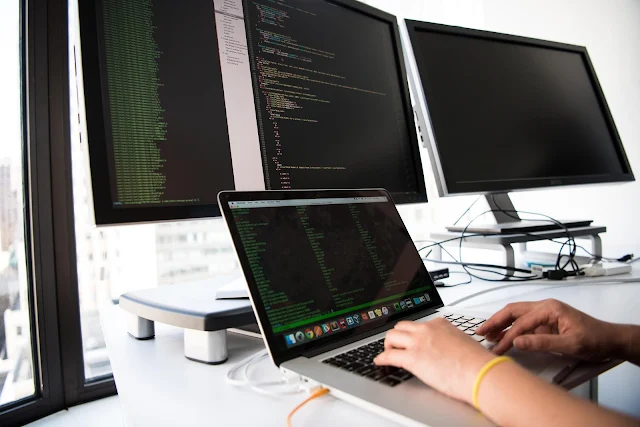Ad Code
Translate
Smart strategies for trading on crypto exchanges
Five Do’s For a Healthy Turnover That Bolsters Talent-Retention
Discover Honeybee Pharmacy (2025 Guide Important Consumer Tips)
What is Ozempic (semaglutide)? (Updated in 2025)
Posture Bra: Improving Back Support and Comfort
How To Find Suitable Properties In Cyprus?
10 Effective Strategies to Improve Domain Authority of Your Website
How to Set Up a Day Trading Workstation Computer (2025 Edition)
You've opened your trading account, studied the markets, and mastered the foundational strategies. Now, it's time to build your day trading workstation—your command centre for executing trades, analysing charts, and managing your portfolio in real time.
A properly designed trading workstation improves efficiency, reaction time, and decision-making, helping you stay organised, focused, and competitive in fast-moving markets. Here's how to build a powerful and practical day trading setup—whether you're a beginner or scaling up your trading operation.
1. Assemble Your Trading Computer: Performance is Key
💻 Recommended Hardware Specs (2025 Minimum Requirements)
- Processor (CPU): Intel i5/i7 (12th+ Gen) or AMD Ryzen 5/7 with at least 4 to 8 cores and 3.0 GHz+ clock speed
- RAM: Minimum 16 GB (32 GB recommended for multi-platform traders)
- Graphics Card (GPU): Dedicated GPU (NVIDIA GTX 1660 or better) to support multiple monitors smoothly
- Storage: 500 GB SSD or higher for fast boot times and rapid data access
- Motherboard: With multi-monitor support, stable voltage regulation, and PCIe expansion capability
💡 Tip: Opt for SSD over HDD—trading platforms load faster, reducing latency when opening charts or executing trades.
🖥️ Monitor Setup
- Beginners: Start with two monitors—one for charts and one for your trading platform or news feed.
- Advanced traders: Use 3–6 monitors for multitasking across platforms, watchlists, indicators, and live data feeds.
Use monitor mounts or stands to keep your desk organised and ensure ergonomic viewing angles.
2. Ensure a Fast and Redundant Internet Connection
🌐 Primary Internet
- Wired (Ethernet) connection preferred
- Minimum speed: 100 Mbps download / 20 Mbps upload
- Low latency and high uptime from a reliable ISP
🔄 Backup Internet
- Use a mobile hotspot, second ISP, or 5G home internet router as a fail-safe. Even a 4G LTE hotspot can help you close positions during a service outage.
📶 A backup router with automatic failover support is ideal for professional traders.
3. Choose the Right Trading and Analysis Software
🛠️ Essential Software Components
- Broker Platform: Choose a broker that offers fast execution, reliability, and a user-friendly interface (e.g., Interactive Brokers, TD Ameritrade, Lightspeed).
- Charting Software: Tools like TradingView, MetaTrader 5, ThinkorSwim, or NinjaTrader offer advanced charting and backtesting features.
- News Feed Services: Platforms like Benzinga Pro, Bloomberg Terminal (high-end), or CNBC Pro provide real-time news, earnings, and economic calendar alerts.
- Screeners and Scanners: Trade Ideas, Finviz, and Stock Rover can help identify daily trading setups.
- Risk Management Tools: Consider adding journaling platforms like TraderVue or Edgewonk to track performance and manage trading psychology.
🔐 Additional Software
- Antivirus software
- Password manager
- VPN for added security (especially if trading from public networks)
4. Protect Your Setup Against Power and System Failure
⚡ Power Protection
- Surge Protector: Essential to guard your system from voltage spikes
- Uninterruptible Power Supply (UPS): A good UPS (e.g., APC 1500VA) can keep your system running for several minutes in case of a power outage, allowing you to close trades safely.
🔌 Make sure your monitors, modem/router, and CPU are all plugged into surge-protected outlets.
5. Optimise Your Desk and Ergonomics
🪑 Desk and Chair
- Use a sturdy desk capable of supporting multiple monitors and hardware
- Consider an adjustable standing desk to reduce prolonged sitting
- Choose an ergonomic chair with lumbar support and adjustable height
💡 Lighting and Placement
- Natural lighting is best—set up near a window with indirect sunlight
- Use adjustable LED task lights to reduce screen glare and eye strain
- Keep the room well-ventilated and clutter-free to maintain focus
6. Choose a Quiet, Dedicated Trading Space
Create a distraction-free zone, ideally:
- In a separate room or office
- Free from household interruptions
- Equipped with soundproofing or noise-cancelling features
Add whiteboards or pinboards nearby for trading plans, schedules, and market notes. The more personalised and organised your space, the more your workflow and discipline improve.
7. Set Up for Future Growth and Scalability
Even if you start small, choose a setup that can scale with you.
🧩 Scalability Tips:
- Use a PC with expandable RAM and PCIe slots for adding more monitors or drives
- Choose modular monitor mounts that can be expanded from 2 to 4 or 6 screens
- Select software platforms with premium features and API access if you plan to automate your strategies in the future
Optional Add-Ons for Enhanced Productivity
- Stream deck or hotkey pad for custom shortcuts
- Cable management trays or sleeves to reduce desktop clutter
- Air purifier or plants to improve air quality and ambience
- Noise-cancelling headphones or speakers for audio alerts and focus
Conclusion: Build a Workstation That Reflects Your Trading Style
There’s no one-size-fits-all approach to setting up a day trading workstation. Some traders thrive on minimalist setups, while others prefer multi-monitor rigs with every tool at their fingertips. What matters most is building a space that aligns with your strategy, risk profile, and workflow.
Start with solid hardware, reliable internet, good lighting, and a distraction-free environment. As you gain experience and confidence, scale up and refine your setup for optimal performance.


Social Plugin